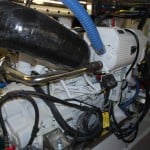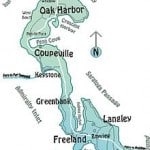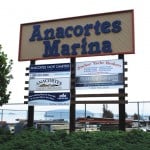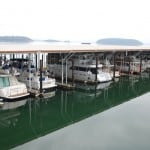Hello all,
Let’s see . . . this boat isn’t much more than an RV on the water . . . or is it?
What does it take to get a boat ready for a 3-4 month cruise – particularly in our cruising waters of the Pacific Northwest, along the Inside Passage from Seattle to SE Alaska?
Winter preparation. The big Cummins diesel engines – two huge monsters that generate 500hp each – are critical to every day’s cruise, and they have to be in tip-top shape. After four years of trial and error, we’ve elected to have Cummins’ service organization do the annual maintenance for us.
Click on any image to enlarge.
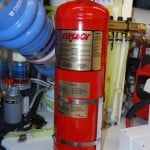
The engine room is "protected" by a large Fireboy fire suppression system - which activates at the first sign of fire, and is also hooked directly into the engine electronic control system to shut down the engines.
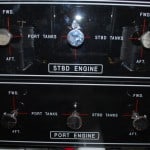
At the front bulkhead of the engine room is a very easy-to-use switching panel that lets you select which fuel tank each engine will draw from.
Two years ago, the yard we used for our Nordic Tug, Cosmo Place, went out of business due to the GFC (that’s a Kiwi acronym for the Global Financial Crisis). Last year, the local yard – that was highly recommended by a friend – performed our 50-hour new-engine maintenance, and rather than look up the proper fuel and oil filters on the Cummins’ online system, he apparently just winged it and installed the wrong fuel filters – and we only found out by accident a day or so later when we attended an owner’s engine maintenance course put on by the local Cummins center in Renton. Our engines are state-of-the-art diesel technology, all electronically controlled, particularly the fuel injectors – squirting the precise amount of diesel into each injector (cylinder) at incredibly high pressure – something like 30,000 psi – at the precise instant that’s optimum for that cylinder to fire. The result is a very clean-burning and fuel-efficient engine – so you don’t see any clouds of blue smoke coming out of the stern of Flying Colours like you see on older boats. That means, though, that engine maintenance is even more critical, and so is cleanliness of our fuel (I’ll discuss “fuel polishing” in a later post)
Many other systems on Flying Colours also have to be serviced, preferably over the winter when the yards are looking for work. This past winter, we used two yards in Seattle – Pacific Yacht Management, the warranty yard for Fleming Yachts in the PNW, and located on the Ship Canal very close to the Ballard Locks – and Yacht Master, located at the north end of Lake Union, and where we had a long list of commissioning finish-up work completed that we ran out of time for last year. Fleming Yachts is really good about warranty work – they don’t quibble about it, and they’re outstanding about getting things taken care of. Between these two yards, we had at least two dozen systems checked and upgraded on Flying Colours – the watermaker, the electrical system, the electronic navigation system, chart plotter monitors in the pilot house that were giving us problems were replaced, locks fitted to the cockpit hatches that give us better security from thieves who happen aboard while we’re gone, the windlass and anchoring system was upgraded with a new anchor that’s us the top-of-the-line available, and an upgrade that’s near and dear to me as the galley slave – a galley cabinet that was fitted out as a spice rack, giving me storage for 40 (!) spice jars. We had a powerful and sophisticated Maretron monitoring system installed and programmed, that keeps track of the battery charging systems for the huge banks of batteries that supply power to everything. The work list went on and on, but you probably get the idea.
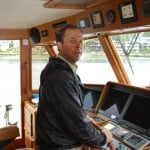
Peter Schaefer at the helm of Flying Colours as we take her through the Ballard Locks and into salt water.
Finally, in late April (the 30th, to be exact) the yard work was completed and it was time to get Flying Colours out to salt water again. Peter Schaefer – our yacht broker from Chuck Hovey Yachts, and a good friend – help me take her through the Ballard Locks early in the morning, and we moored her Port of Seattle’s Shilshole Marina for 4-5 days on their guest dock. Shilshole is convenient to home, and we can make daily trips to provision and load up with all the gear at home that we took off to make room for the winter work. Besides, there are several really good restaurants nearby the marina – including Ray’s Boathouse and Anthony’s Homeport.
On May 6th, it was time to head for Anacortes, where the final provisioning and loading would take place. By car, the drive up from home to Anacortes takes about 1½ hours, almost all at freeway speeds – but on the water when you’re cruising at 10 knots it’s easily a 5-6 hour trip, and that’s if the current isn’t too much against you.
We departed Shilshole at 7AM, and made our way past Everett, along the eastern side of Whidbey Island (here’s a tidbit for you – Whidbey Island is the 40th largest island in the U.S., and the 5th longest island in the contiguous US), then along Saratoga Passage between Whidbey and Camano Islands. Near the top end of Whidbey we stayed well east of Oak Harbor, turning right to head into the Swinomish Channel.
Our preferred route to Anacortes is via La Conner and the Swinomish Channel, as it cuts off 2-3 miles compared to the route through Deception Pass – particularly so since Anacortes Marina is on the east side of Fidalgo Island.
Before entering Swinomish Channel from the south, you first have to navigate an extremely shallow mudflat, being very careful to stay within the dredged channel (it’s the gash across the bottom half of the photo below left). I was at the helm for this passage, and Kap’s duty was to keep us in the center of the channel by sighting with binoculars on a set of range finders on the shore far behind us. Even at high tide, the channel was barely 11’ deep, and our draft is 5’, so there isn’t much room for error.
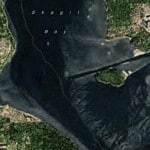
The very shallow dredged channel that leads to the Swinomish Channel is very obvious from this Bing satellite photo. As you travel through it, you must carefully watch the range finder markers behind you at far left (not visible).
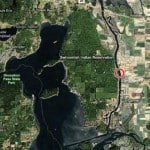
The Swinomish Channel is the thin ribbon snaking from bottom to top in this Bing satellite image (with the red circle just north of La Conner). Highway 20 leading into Anacortes runs left across the top.
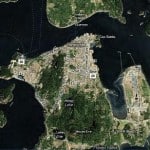
Anacortes - at the top end of Fidalgo Island - is the squared-off area in this Bing satellite image. The north end of the Swinomish Channel can be seen at lower right. The two faint lines at the north end of the peninsula are oil tanker pump-off docks, and to the left of them on the main peninsula is where Anacortes Marina is located.
The Swinomish Channel is narrow and a bit twisting (you can see it as the fairly faint ribbon of dark in the middle photo to left). At the bottom end of the Channel is the quaint town of La Conner, in the heart of the Skagit Valley tulip area. It’s always a teaser to tie up on one of the piers in the center of town to have lunch, but so far, we’ve always been in too much of a hurry to keep going. North of La Conner, the Channel is quite shallow, and you need to pay close attention to the red/green navigation buoys marking the deeper areas of the Channel. With the no-wake speed zone through here, it’s rather slow going, but it still gets us through faster than going around to the west.
We arrived at Anacortes at 2PM. Planning to get an early start on our summer’s cruise a few days later, we decided to stop for fuel at Cap Sante Marina – which is always a big gulper! Spread across our four fuel tanks, we took on a total of 548 gallons of diesel, and at $3.17/gallon (which includes a 20¢ discount for pumping over 500 gallons), the bill came to $1,709.62! That should get us to Juneau.
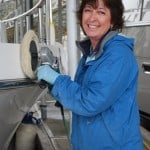
Dana Bower keeps dozens of boats around Anacortes Marina in great looking shape. She took pity on us with our blue-hulled Nordic Tug, and now she's doing the same for Flying Colours.
We were in our slip at Anacortes Marina by 3PM, and Dana (our wonderful wash/wax/cleaning person) was waiting on the dock to get started on a wash/wax job. Squeezing us into her schedule, Dana worked over the weekend to get Flying Colours into spic-and-span shape.
Throughout this time, we thought we’d get away in short order – but one thing after another got in the way. Kap’s back problem resurfaced with a vengeance, and after an MRI it was diagnosed that she has a herniated disc in the lower vertebrae. Then her father was scheduled for surgery on a recurring cancer tumor, then a power distribution box on the boat was found to be defective – and all the while there were days and days of fiddly work that needed to be done to get Flying Colours ready.
The kayak and bicycles were loaded aboard; the galley was stocked with enough food to feed five for 3-4 months (the five include two dogs and a cat); the lazarette (the large storage area beneath the aft cockpit and behind the engine room) had to be organized and a ton of stuff stowed; our clothing had to be brought on board and stowed. None of this sounds like much, but it is. One certainty during loading is . . . it will be low tide at the dock – and the gangway ramp down will be at its steepest.
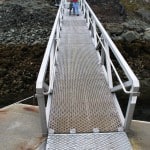
The ramp down to A Dock is really steep at low tide. The darker half of the rocky shore shows just how low a low tide can be.
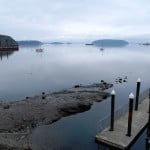
Looking across Padilla Bay from the top of ramp at A Dock. The rock outcropping in the foreground is completely submerged at high tide. The white cloud area on the horizon hides Mt. Baker - and it's really spectacular when clear.
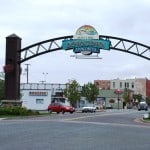
Downtown Anacortes is small, but doesn't lack for good restaurants - Bellisima is our favorite Italian restaurant, Rock Fish Grill is great for lunch pizzas, and Gere-A-Deli is good for takeaway sandwiches to eat on the boat.
Anyway, the hope is that all that’s behind us. We’re making final preparations to depart tomorrow (Friday), heading for Sidney, B.C. – where we’ll provision with at least two weeks of meat and vegetables (these can’t be brought into Canada, so we get them immediately after crossing the border). We’ve already purchased five cases of very nice B.C. wine from a favorite wine and spirits purveyor in the little village of Ganges on Salt Spring Island (it’s a tiny hole-in-the-wall place called The Local, owned by Steve and Colleen Knight – wonderful people!), and while in Sidney we’ll rent a car and drive there to pick up our wine – that should last us most of the summer.
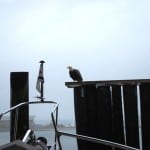
This morning as Kap was plotting our course, she looked up and saw a very wet bald eagle perched on the piling breakwater just 10' in front of Flying Colours' bow. It had a fish in its talons and was about to have breakfast.
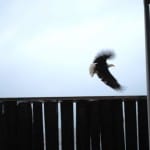
No sooner had I grabbed two photos and he/she decided to fly away. The speed with which this happened didn't give me enough time to set up for a really crisp photo.
So . . . tomorrow we finally cast off – hopefully until the end of September, and hopefully the cruise will take us to SE Alaska – and more importantly, back from SE Alaska. I’ll write more tomorrow as we get underway.
Ron

